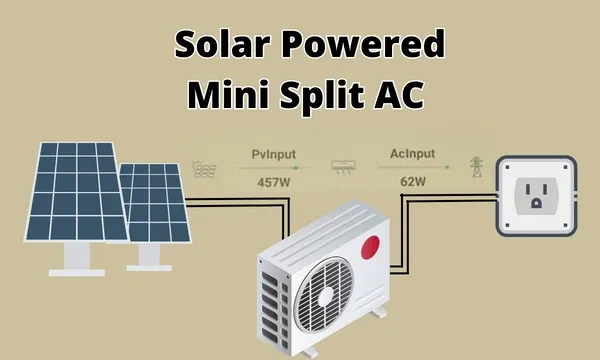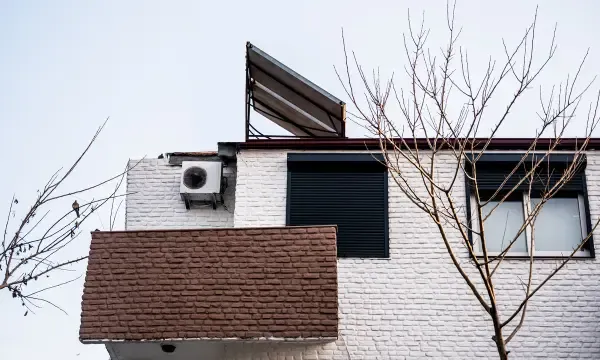How many solar panels to run a mini split

I get a lot of sun and would be great to lower my HUGE summer electric bill. "Lots of Sun = Lots of Heat = A/C all of the time = $$$$".
In a step to reduce the electricity bill, most people resort to exploiting the potential of solar panels to power their largest load, which is heating and cooling devices.
Since mini split units can provide air conditioning and heating while using less energy to start up and run.
Over the past few years, a range of mini split unit options that are compatible with solar panels have appeared, and even if you already have a conventional mini split, this does not mean that solar energy is out of the question.
In this article, you'll see these options, understand the difference between them, and provide a step-by-step process for calculating the number of panels and batteries required to power your mini split on solar.
How many Options are there for Solar powered Mini Split?
There are three different options available. These vary based on the type of current that the mini split is running in. Let's see them below.
- AC Mini Split units (standard mini splits)
- DC Mini Split units
- Hybrid mini split units
Let's take a look at each one.
1. AC Mini Split units
.webp)
2. DC Mini Split Units

To understand the beauty of this particular dc solar mini split, you have to understand a little bit about electricity. This brand uses direct current (DC) electricity, as opposed to alternating current (AC). DC makes it solar ready. why DC better for a solar powered air conditioner?
Semi conductors use DC power, and over the past half century they have proliferated. They are found in almost all major appliances (TVs) and have to convert the power from AC to DC. That loses energy. The heat from the back of tv set, etc is wasted energy from converting ac to dc. A solar powered air conditioner has a similar problem in energy loss due to power type conversion, but in reverse.
A solar powered mini split usually has to convert DC to AC. That’s because solar panels make DC energy. Most air conditioning units use AC power. The solar powered mini split pictured here uses DC, so no energy is lost in converting from one type of current to the other. It will save 10 to 40% over a solar powered mini split that uses AC power. And that’s what it’s all about…saving energy and money!
This type of mini split unit requires a set of deep cycle batteries, a solar charge controller and of course an array of solar panels. Deep cycle solar batteries are an absolute must, because only deep cycle variety can handle the ups and downs of solar charges that come with a solar powered air conditioner setup.
DC solar mini split units can be found operating at 24 volts DC for units of sizes less than 9000 BTUs and 48 volts DC for units of larger sizes (12000–18000–24000 BTUs).
3. Hybrid Mini Split Units

The hybrid mini split units contain electronics that allow us to run them on DC and AC power at the same time. What's interesting about this unit is that you don't have to have an inverter or batteries.
When it's sunny, the mini split takes its energy from the sun, and at night it takes it from the grid. Also, these units will always prioritize DC power first, then utilize your existing AC power when the panel's output is low.
Note that you don't have to live in an on-grid house to possess that kind of technology; you can connect them only with solar panels, and they will work. In fact, you can use these hybrid units completely with solar;
During the day, it works directly with DC power that comes from the solar panels; at night or when the sun is not shining, the unit uses the solar energy stored in a battery after passing through the inverter.
What is the Best solar-powered Mini Split?
Practically every conventional, hybrid, or DC mini split unit can be powered on solar, whether you are living in a home connected to grid or when you are in a remote location not connected to the grid.
Amidst many different opinions, the answer generally depends on the total cost of the system that you choose.
For example, the hybrid mini split does not require additional equipment, such as an inverter and batteries, but its cost is usually very high. In addition, you will be at the mercy of the electricity grid's prices to operate your unit when there is no sunlight.
For a conventional mini split, it may be more affordable, but you will need additional equipment, such as an inverter, batteries, and charge controllers, which means the total costs will increase.
However, most homeowners set up the solar system and use a conventional mini split AC unit.
How Much Energy Does a Mini Split Use per Day?
Compared to traditional ducted heat pumps, mini-split units consume less energy to start up and run.
Even so, because they run for several hours a day, the power consumption of mini-splits is still relatively higher than that of other home appliances.
The amount of energy used by the mini split heat pump is proportional to the unit's heating and cooling capacity, which is measured in BTU (British Thermal Units) or tonnage, and its efficiency.In terms of wattage, a mini split heat pump uses anywhere from 700 to 3000 watts.
The important thing to note is that most of the energy that mini splits need is used to run the compressor, and most units on the market today have inverter technology that allows the compressor to use less energy to run, meaning that the power usage varies according to the desired output.
This technology is what makes operating mini-splits with solar panels much easier.
In terms of energy consumption, the unit uses from 5 to 16 kWh per day. This range is approximately 7 to 13 kWh for the popular systems (12,000 to 24,000 BTU).
The following table provides some rough estimates of the hourly and daily energy use for new mini-split units of different sizes.
| Mini Split Size | Avg. Running Wattage | Wattage at Set Temperature | Average Daily Energy Use for new mini split |
|---|---|---|---|
| 0.75 ton (9000 BTU) | 700W | 150 – 200W | 6 kWh |
|
1 ton (12000 BTU) |
900W | 200 – 300W | 8 kWh |
| 1.25 ton (15000 BTU) | 1100W | 300 – 400W | 9 kWh |
| 1.5 ton (18000 BTU) | 1400W | 350 – 500W | 10 kWh |
| 2 ton (24000 BTU) | 1800W | 550 – 750W | 12 kWh |
| 2.5 ton (30000 BTU) | 2800W | 700 – 1000W | 14 kWh |
How Much Power does a Solar Panel Produce?
To find out how many panels are needed to run a mini-split, you first need to find out how much energy is expected to be generated from a single solar panel during the day.
The average residential solar panel output is between 250 and 400 watts of power and between 20 and 40 volts. This means that they will produce between 0.25 and 0.40 kilowatt-hours (kWh) per hour.
There are several factors that affect the amount of energy that solar panels will generate per day.
- The Orientation and tilt angle of solar panels.
- The region and weather conditions (peak sun hours).
- Shading.
It can be said that the region and weather are the most important factors because normally the other two factors can be controlled and improved, but the region and weather are completely out of our control.
On average, a standard residential solar panel in the United States produces from 1 to 2 kWh per day, which is enough energy to fully charge a 12V 100Ah battery in a day.
I've already done the math in this article: How Many Solar Panels Are Required to Power a Heat Pump?
How many Solar Panels do you Need to Run a Mini Split?

Now that we know how much power a mini split heat pump uses and how much power a residential solar panel generate, we can calculate how many solar panels we need to power a mini split AC.
The number of panels needed depends on the unit's power requirements and the amount of energy a single panel produces per day.
Number of solar panels = Average Daily kWh Usage / Average Daily kWh produced by single panel
Let's calculate the number of 350-watt solar panels needed to power a 18,000 BTU mini split:
The average 350W solar panels in a location with good sunlight (4 peak sun hours) can produce about 1.5 kWh of energy per day.
The average daily power consumption for an 18k BTU mini split is around 10 kWh.
Number of 350-watt solar panels required = 10 kWh / 1.5 kWh = 6.6 (7) solar panels
Now, by installing 7 panels of 350 watts, you will be able to power your mini split during the peak sun hours of the day. But you'll need batteries to supplement the panels when there is no sunlight.
The following tables illustrate how many 350W solar panels you need to power different sizes of mini splits:
| Mini Split Size | No. of 350W Solar Panels |
|---|---|
| 0.75 ton (9000 BTU) | 4 |
|
1 ton (12000 BTU) |
5 |
| 1.25 ton (15000 BTU) | 6 |
| 1.5 ton (18000 BTU) | 7 |
| 2 ton (24000 BTU) | 8 |
| 2.5 ton (30000 BTU) | 10 |
Conclusion
Combining a mini split unit with solar panels is a great way to heat and cool a house, RV, camper, or trailer for many reasons.
Most of them have low power usage, which reduces the number of solar panels you are going to need compared to the number of panels needed to run a central heat pump.
To run a mini split unit using solar energy, you have three options:
You can either get a conventional mini split unit and set up the number of panels and batteries you will need (the inverter is an integral part of this setup), or get a hybrid mini split unit that has inputs in DC, or get a DC solar mini split unit that uses low DC voltage so you can connect it directly to the batteries (12V, 24V, or 48V).
By integrating these units with solar panels, you will get a solution that is not only feasible for reducing energy bills but also environmentally friendly.

